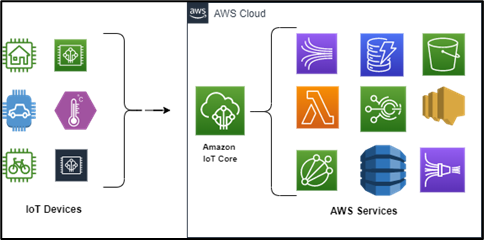- Consulting
- Training
- Partners
- About Us
x
The Internet of Things (IoT) refers to physical items equipped with sensors, embedded software, computing power, and other technologies. It may communicate with other devices over the Internet or other local communication networks. In addition, devices occasionally communicate with one another on a local network or with cloud services to perform specific tasks.
When we think about IoT, the devices need to connect to the cloud, such as Amazon Web Services (AWS), Microsoft Azure, Google Cloud Platform (GCP), Alibaba Cloud, Oracle Cloud, IBM Cloud, etc.
Amazon Web Services (AWS) is a well-known cloud service company. There are many services available not just in IoT but also in other applications. AWS offers a variety of services for IoT applications, including FreeRTOS and AWS IoT GreenGrass for device software, AWS IoT Core, AWS IoT Device Management, AWS IoT Device Defender, and AWS IoT Fleetwise for control services, and AWS IoT Analytics, AWS IoT Events, AWS IoT Sitewise, and AWS IoT TwinMaker for analytics.
To learn more about AWS IoT 1-Click, here is an exciting blog to get you started.
The first step after obtaining sensor data is to create a connection between the cloud and the device when it comes to IoT. AWS’ IoT core enables the communication between edge IoT devices and AWS services.

If you do not have an AWS account, first create the account as a free tier log in to the AWS free tire account. Then, in the search bar, enter IoT Core, then in the services blade, click on IoT Core.

Click Connect on AWS IoT Blade to register the new device on the left side; then click Get started. After that, in the Onboard a device section, click Get started. AWS also provides onboard many devices, which will help to onboard many devices at a time.
In the Connect to AWS IoT console, click Get started.
AWS provides the readily available SDK (Software Development Kit), which will help you directly connect to AWS IoT. According to your application, you can select which OS (Operating System) platform and SDK are needed; on my laptop, Windows OS is running and python is installed, so I go for Windows and python option.
After clicking Next, you can see the Registered Thing name and click Next Step.
When we register a device, AWS immediately produces a thing policy with the same name, allowing us to access only through the SDK device we are about to download. SDK and all Nassery certifications are included in the Download kit. For example, to get the SDK kit for Windows, click the Windows option to get the download.
In Configuration and test your device console steps are given how to run the SDK.
First, unzip the connect_device_package. Make sure python is installed already, open the Windows PowerShell run the following command.
|
1 |
Set-ExecutionPolicy -ExecutionPolicy Bypass -Scope Process |
Type yes to change the execution policy and then type .\start.ps1, and you can see the device started to publish the data to AWS IoT Core.
The console shows the device state as connected to your device and received data displayed below. This ensures that the IoT device is securely attached to AWS IoT Core and clicks Done.
You can see the registered thing name displayed on the console.
Another approach to observing the receiving data is navigating to the AWS IoT Core interface, clicking Test, and selecting the Subscribe to a topic option. Inserts # in the topic filter section, which implies a wildcard listening to all topics for that specific device. Select the Subscribe option.
Now, go to Windows PowerShell and run .\start.ps1 again.
You can see data in the console which is sent by the device.
We have successfully registered the device in AWS IoT Core and got data from it. Then we can write Rules based on our application like storing data in S3, storing data in the database, triggering lambda, triggering AWS IoT Analytics, triggering SNS messages, and so on.
CloudThat is the official AWS Advanced Consulting Partner and collaborates with top IT giants to provide cloud strategy, build solutions, and manage infrastructure. We are on a mission to build a robust cloud computing ecosystem by disseminating knowledge on technological intricacies within the cloud space. Our blogs, webinars, case studies, and white papers enable all the stakeholders in the cloud computing sphere.
Feel free to drop a comment or any queries you have regarding AWS services, cloud adoption, consulting, and we will get back to you quickly. To get started, go through our Expert Advisory page and Managed Services Package that is CloudThat‘s offerings.
|
Voiced by Amazon Polly |

Vasanth Kumar R works as a Sr. Research Associate at CloudThat. He is highly focused and passionate about learning new cutting-edge technologies including Cloud Computing, AI/ML & IoT/IIOT. He has experience with AWS and Azure Cloud Services, Embedded Software, and IoT/IIOT Development, and also worked with various sensors and actuators as well as electrical panels for Greenhouse Automation.
Our support doesn't end here. We have monthly newsletters, study guides, practice questions, and more to assist you in upgrading your cloud career. Subscribe to get them all!
Comments